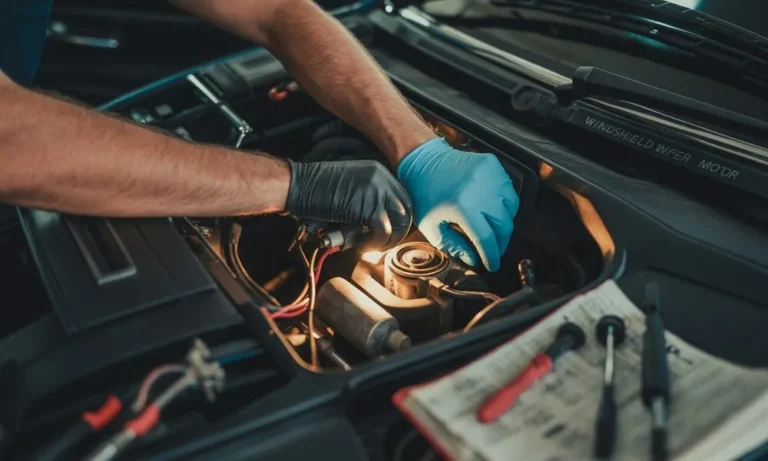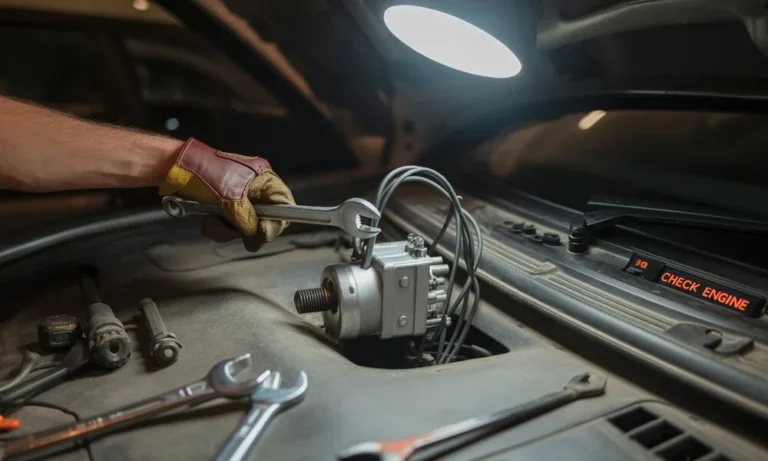How To Replace Windshield Wiper Motor
How to replace windshield wiper motor is a common concern for drivers facing visibility issues during rain or snow. A working front windshield wiper motor is crucial for safe driving, as it powers the wipers that clear your windshield. When the motor fails, wipers may stop moving, work intermittently, or make unusual noises. These are clear signs you may need a windshield wipers motor replacement. In this article, we’ll explain how to diagnose a faulty motor, walk you through the replacement steps, discuss repair costs, and cover common issues. Whether you’re planning to fix it yourself or want to understand the process, this guide will help you stay safe on the road.
What Can Go Wrong with a Windshield Wiper Motor?

The windshield wiper motor is essential for keeping your visibility clear in rainy or snowy weather. But like any component in your vehicle, it can experience issues over time. Here are some common problems that may require a windshield wipers motor replacement or rear wiper motor replacement:
1. Electrical Failures
Faulty wiring, bad connections, or electrical shorts can prevent the wiper motor from working properly. These failures often require diagnostics to determine whether the issue lies with the motor itself or the electrical system.
2. Motor Burnout Due to Overuse or Age
Over time, the motor can simply wear out. Frequent use, especially in areas with heavy rain or snow, can speed up the wear, eventually leading to a complete motor failure.
3. Corrosion or Water Damage
Despite being designed to resist water, moisture can sometimes enter the motor housing, leading to corrosion. This is a common reason for rear wiper motor replacement, especially in SUVs or hatchbacks where the rear wiper is more exposed.
4. Mechanical Linkage Issues
Even if the motor is functioning, broken or jammed linkages can prevent the wipers from moving. These issues might cause unusual wiper movement or complete failure.
5. Blown Fuse or Faulty Relay
If your wipers suddenly stop working, a blown fuse or bad relay could be the culprit. These are inexpensive fixes but are often misdiagnosed as motor failure.
Symptoms of a Failing Wiper Motor:
- Wipers move slowly or erratically
- Wipers don’t move at all
- Strange noises during operation
- Wipers stop mid-swipe
If you’re noticing any of these signs, it may be time for a windshield wipers motor replacement or rear wiper motor replacement. Addressing these issues promptly ensures safe driving conditions and prevents further damage.
You should also know about How To Replace A Sunroof Motor.
How to Identify a Faulty Windshield Wiper Motor
If your wipers aren’t working properly, don’t rush into a windshield wipers motor replacement or rear wiper motor replacement just yet. Many related issues can mimic motor failure. Here’s a step-by-step process to help you diagnose the problem accurately:
1. Check Fuses and Relays
Before anything else, inspect the wiper fuse and relay in your vehicle’s fuse box. A blown fuse or faulty relay can cut power to the motor, causing the wipers to stop working entirely.
- What to look for: Burnt fuse, corroded or clicking relay
- Tip: Replacing a fuse is inexpensive and worth checking first.
2. Test the Wiper Switch
Sometimes the problem lies with the wiper switch, not the motor. Try switching between different wiper speeds and see if anything responds.
- What to look for: No response or intermittent function
- Tip: If speeds don’t change or the switch feels loose, it may be the issue.
3. Inspect the Wiring and Connectors
Loose, damaged, or corroded wiring can interrupt the signal to the wiper motor.
- What to look for: Frayed wires, loose connections, signs of water damage
- Tip: Wiggle connectors gently while operating the wipers to detect intermittent faults.
4. Listen for Unusual Sounds
Turn on the wipers and listen closely. A faulty motor might hum, grind, or click without moving the wipers.
- What to listen for: Buzzing or clicking from the motor area without blade movement
- Tip: No sound at all could still mean a power issue, not just a bad motor.
5. Use a Multimeter to Test Power at the Motor
Disconnect the motor connector and use a multimeter to check if voltage is reaching the motor when the switch is on.
- What to look for: No voltage = electrical issue; voltage present = likely a failed motor
- Tip: This is the most reliable test before deciding on a windshield wipers motor replacement.
When to Consult a Mechanic
If you’re unsure or the issue persists after these checks, it’s time to consult a professional. A certified mechanic can confirm if you need a rear wiper motor replacement or windshield wipers motor replacement and ensure the job is done safely and correctly.
How to Replace a Windshield Wiper Motor in 7 Easy Steps

If your wipers have stopped working or are behaving erratically, it might be time for a windshield wipers motor replacement. Whether you’re dealing with a front windshield wiper motor issue or just want to tackle the repair yourself, here’s how to do it in 7 straightforward steps.
Step 1: Turn Off the Vehicle and Disconnect the Battery
Before beginning any work, make sure the vehicle is turned off and the battery is disconnected. This prevents accidental shocks and protects the electrical system during the replacement process.
Step 2: Remove the Wiper Arms
Lift the wiper arms away from the windshield and use the proper tool or a socket wrench to remove them. Keep the nuts and washers in a safe place—they’ll be reused during reassembly.
Step 3: Take Off the Wiper Cowl or Access Panel
The front windshield wiper motor is usually located beneath a plastic or metal cowl at the base of the windshield. Remove this panel carefully to gain access to the motor and linkage system.
Step 4: Disconnect the Motor Wiring Harness
Find the motor’s electrical connector and carefully disconnect it. Check for any corrosion or damaged pins, which can also cause performance issues.
Step 5: Unbolt and Remove the Faulty Motor
Use a socket or wrench to remove the bolts securing the motor. Depending on your vehicle, the motor may also be attached to a linkage system. Detach it carefully without forcing any components.
Step 6: Install the New Motor and Reconnect Components
Position the new front windshield wiper motor in place and bolt it down securely. Reconnect the wiring harness and, if applicable, attach it to the wiper linkage.
Step 7: Test the New Motor and Reassemble Everything
Before reattaching the cowl and wiper arms, reconnect the battery and test the motor to ensure it’s functioning correctly. Once confirmed, reassemble everything and secure all fasteners.
How Much Does It Cost to Replace a Windshield Wiper Motor?
If your wipers have stopped working and you’re considering a windshield motor replacement, understanding the costs involved can help you budget and decide between DIY and professional repair.
DIY Cost Breakdown
Replacing the motor yourself can save money, especially if you’re comfortable working on your vehicle.
- Parts: $50–$150
The cost of a front windshield wiper motor varies depending on the make and model of your vehicle. - Tools: $0–$50
Most people already own the basic tools required, or they can be borrowed or rented cheaply. - Total DIY Cost: $50–$150
Professional Mechanic Cost Breakdown
Hiring a mechanic for a windshield wiper motor replacement ensures the job is done correctly, especially if electrical diagnostics or linkage alignment is needed.
- Labor: $80–$150
Labor costs depend on the complexity of the job and local shop rates. - Parts: $70–$150
This can vary based on your vehicle’s make, model, and whether OEM or aftermarket parts are used. - Total Professional Cost: $150–$300+
Factors That Affect Windshield Motor Replacement Cost
Several factors influence the overall cost:
- Vehicle Type: Luxury or less common models tend to have pricier parts.
- Part Availability: Hard-to-find parts may drive up prices.
- Shop Rates: Labor rates vary by location and mechanic experience.
Final Thoughts
Replacing a windshield wiper motor can be a straightforward task with the right tools, but if you’re unsure or prefer expert help, Texas Reliable Auto Glass is here to assist. Whether it’s a front windshield wiper motor or a windshield motor replacement, we offer reliable service to get your wipers working perfectly again. Have questions or need assistance? Contact us today at Texas Reliable Auto Glass! Let us help you get back on the road with clear visibility.
FAQs
How Long Does A Windshield Wiper Motor Last?
Most wiper motors last between 8 to 10 years, depending on usage, weather conditions, and vehicle maintenance. Heavy use in rainy or snowy climates may shorten its lifespan, leading to the need for a windshield motor replacement sooner.
Can I Drive With A Faulty Wiper Motor?
Technically, yes—but it’s not recommended, especially in poor weather. Without functioning wipers, your visibility can be severely compromised. Replacing a front windshield wiper motor is a safety-critical repair.
Are Aftermarket Wiper Motors Reliable?
Many aftermarket wiper motors are reliable and more affordable than OEM (Original Equipment Manufacturer) parts. However, quality can vary by brand. Always choose a reputable manufacturer when considering a windshield wipers motor replacement.
What Are The Symptoms Of A Failing Wiper Motor?
Common signs include slow-moving wipers, non-functional wipers, unusual noises, or wipers that stop mid-swipe. These issues often indicate the need for a front windshield wiper motor replacement or inspection of the electrical system.

